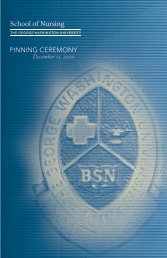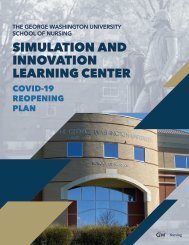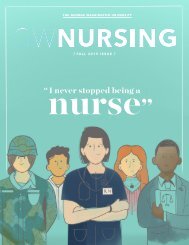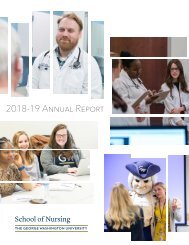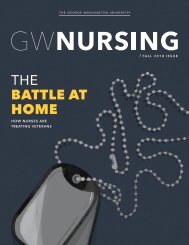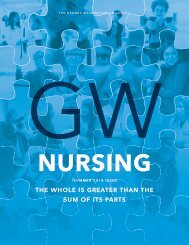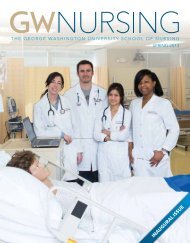GW Nursing Magazine Spring 2016
GW Nursing is a publication of the George Washington University School of Nursing. The magazine tells the story of GW nurses and their endeavors in the areas of education, research, policy and practice.
GW Nursing is a publication of the George Washington University School of Nursing. The magazine tells the story of GW nurses and their endeavors in the areas of education, research, policy and practice.
Create successful ePaper yourself
Turn your PDF publications into a flip-book with our unique Google optimized e-Paper software.
<strong>GW</strong> <strong>Nursing</strong> News<br />
<strong>Nursing</strong> Dean Pamela<br />
Jeffries, center, clips<br />
the ribbon at the<br />
opening of the<br />
Johnson Lab. Joining<br />
her (left to right) are<br />
Eileen Curtis, president<br />
and CEO, Dulles<br />
Regional Chamber<br />
of Commerce;<br />
Christopher Deering,<br />
senior associate<br />
dean and associate<br />
provost of the <strong>GW</strong><br />
Virginia Science and<br />
Technology Campus;<br />
Mary Jean Schumann,<br />
SON senior associate<br />
dean; Mel Williams, Jr.,<br />
retired vice admiral<br />
(USN) and associate<br />
provost <strong>GW</strong> Military<br />
and Veterans Affairs;<br />
and Patricia Davis,<br />
director of the lab.<br />
New ‘Hospital’ Opens in SON Skills<br />
and Simulation Lab<br />
From an article published<br />
Oct. 28, 2015, in <strong>GW</strong> Today<br />
by James Irwin, associate editor<br />
A state of the-art 3,000-squarefoot<br />
expansion has increased<br />
the footprint of the School of<br />
<strong>Nursing</strong>’s (SON) clinical skills<br />
and simulation learning lab to<br />
10,000 square feet.<br />
The new Johnson Lab—named<br />
after SON founding dean Jean<br />
Johnson—is billed as a simulated<br />
hospital, offering 10 beds for static<br />
and mid-fidelity mannequins that<br />
imitate patients from infants to<br />
the elderly. The static mannequins<br />
are for specific tasks, while the<br />
mid-fidelity mannequins include<br />
more lifelike features such as<br />
pulses and heartbeats.<br />
In October, members of the<br />
SON community—including Dean<br />
Pamela Jeffries, administrative<br />
leaders, faculty and students—cut<br />
the ribbon on the new lab at the<br />
George Washington University’s<br />
Virginia Science and Technology<br />
Campus. The gala ceremony was<br />
among the celebratory events<br />
observed during the SON fiveyear<br />
anniversary.<br />
At the ceremony, Dr. Jeffries,<br />
a longtime advocate for using<br />
simulations to bridge classroom<br />
learning and real-life clinical<br />
experience, described the<br />
existing space and the lab<br />
expansion as an environment<br />
for nursing students to practice<br />
the full scope of their study,<br />
“… something they cannot do<br />
during clinical training with<br />
real-life patients, where the<br />
instructor steps in when<br />
something goes wrong.”<br />
“When you look at traditional<br />
clinical training, you are always<br />
a student nurse and always<br />
following your instructor. What<br />
we’re doing here is having you<br />
rehearse your scope of practice in<br />
the RN role,” she said.<br />
Associate Dean for<br />
Undergraduate Studies Billinda<br />
Tebbenhoff sees the lab as an<br />
opportunity for repeated practice.<br />
“We always say in nursing that you<br />
can’t make a mistake, which is<br />
sort of incompatible to being a<br />
human being,” she said. “That’s<br />
why we need simulations, so it<br />
becomes muscle memory.”<br />
6 /






